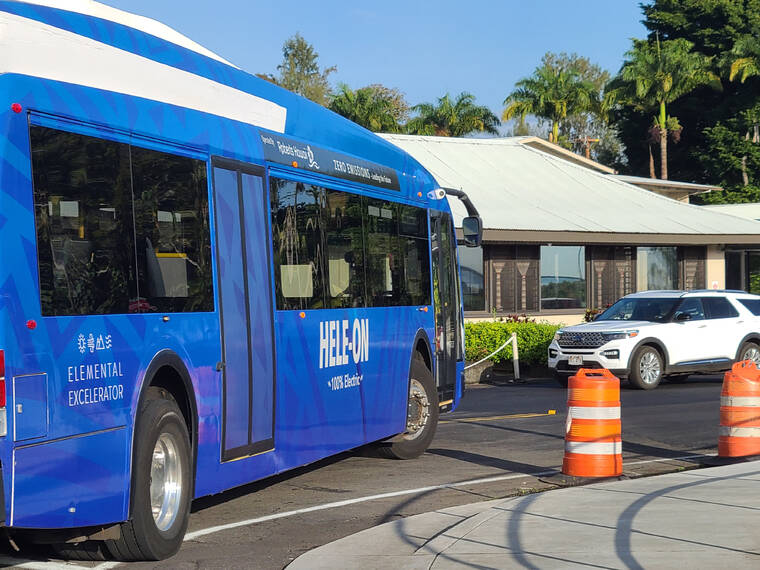Hawaii County is planning to jump into electric buses in a big way with 10 new buses planned as early as next year and an East Hawaii charging network as a pilot project.
The new buses, along with other new and used vehicles, will bring the fleet back up to 55 vehicles, following several dismal years when as few as 12 county buses were on the road at any time, forcing the government to lease buses at expensive day rates from local transportation companies.
Currently, the average age of the Hele-On bus is 17.8 years, said Mass Transit Administrator John Andoh in an update on the county’s mass transit master plan Tuesday to the council Committee on Public Works and Mass Transportation.
Andoh said three hydrogen buses are being added to the fleet this year, with the first bus expected on the island today.
The agency has enough money to purchase 36 26-45-foot buses, he said. Twenty-six new buses should come next year and 18 in 2024.
Five 35-foot battery electric buses and a network of charging stations, initially at the Hilo baseyard, Mooheau bus station and Puna Kai shopping center, would be obtained through a contract addendum on the state of Hawaii’s master contract with Arizona-based Sustainability Partners LLC. That would be followed with five additional electric buses being purchased with a federal grant, said Andoh.
Under the plan with Sustainability Partners, the private company would provide the buses and build the charging network and maintain the project for 10-12 years in exchange for the county paying a charging fee and annual fee for the buses, currently estimated at $4.01 per mile per bus, along with $9,529 for 65 charging events per month, with $100 per charging event after that.
The county would use general excise tax funds for the project.
“In essence, we’re paying for them to build the infrastructure for us,” Andoh told the council Finance Committee on Tuesday.
Preliminary plans include photovoltaic cells to power the charging system, including a 1.5 megawatt system and battery backups, said Riley Saito, energy specialist in he county Department of Research and Development.
“This would bring 20 buses to full charge daily with no feedback to grid and ideally no draw from the grid,” Saito said.
Finance Committee Chairman Matt Kanealii-Kleinfelder was happy to hear about the project.
“This would be one of the most interesting thing that’s happened for a long time,” Kanealii-Kleinfelder said. “I think that would be a huge step for us as a county. If our electricity that we’re using to charge our buses is based on fossil fuel we can do better.”
The committee advanced Resolution 345 with a positive recommendation, noting that it’s only a first step and is nonbinding to the county until more details become available and a contract addendum is signed.
Another measure, Resolution 348, scheduled to be heard today by the full council, will accept 12 used buses from the City and County of Honolulu to add to add to the fleet. While council members have in the past resisted the idea of using Honolulu’s hand-me-downs, the iconic old yellow buses actually break down less often than the county’s other buses, transit staff has said.
“This allows us to replace the eight worst-performing buses for a two-year period so it allows us to buy time,” Andoh said.

